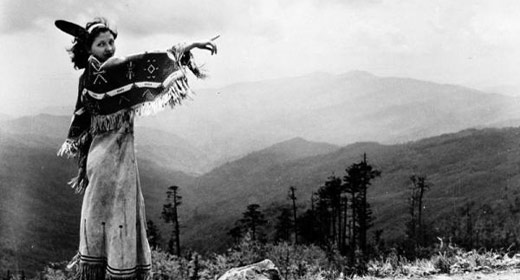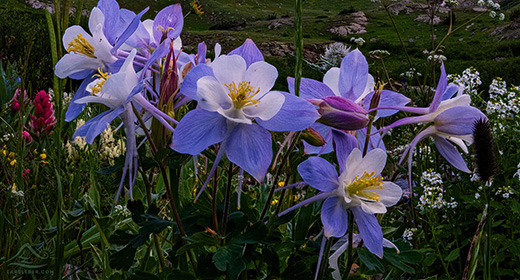In February of 1757, the great Cherokee leader Attakullakulla came to South Carolina to negotiate trade agreements with the governor and was shocked to find that no white women were present…

“Since the white man as well as the red was born of woman, did not the white man admit women to their council?” Attakullakulla asked the governor.Carolyn Johnston, professor at Eckerd College and author of Cherokee Women in Crisis; Trail of Tears, Civil War, and Allotment, 1838-1907, says in her book that the governor was so taken aback by the question that he took two or three days to come up with this milquetoast response: “The white men do place confidence in their women and share their councils with them when they know their hearts are good.”
Europeans were astonished to see that Cherokee women were the equals of men—politically, economically and theologically. “Women had autonomy and sexual freedom, could obtain divorce easily, rarely experienced rape or domestic violence, worked as producers/farmers, owned their own homes and fields, possessed a cosmology that contains female supernatural figures, and had significant political and economic power,” she writes. “Cherokee women’s close association with nature, as mothers and producers, served as a basis of their power within the tribe, not as a basis of oppression. Their position as ‘the other’ led to gender equivalence, not hierarchy.”
One of the hardest things for the colonists to comprehend was the Cherokee kinship system. It was based on the matrilineal structure—the oldest social organization known to man (woman?) in which lineage is traced through the mother and maternal ancestors. The most important male relative in a Cherokee child’s life was his mother’s brother, not his father. In fact, the father was not formally related to his offspring. According toTheda Perdue, professor at the University of North Carolina and author of Cherokee Women: Gender and Culture Change, 1700-1835, white men who married Indian women were shocked to discover that the Cherokees did not consider them to be related to their children, and that mothers, not fathers, had control over children and property.
Women owned the houses where the extended family lived,and daughters inherited the property from their mothers. In order to prevent white men from marrying Indian women for profit–as the Cherokee land was coveted by white colonists–the husband’s Cherokee citizenship was revoked if he decided to leave. “Should a white man abandon his Cherokee wife without good reason, he forfeited Cherokee citizenship and paid a settlement determined by the Cherokee Committee and Council for breach of marriage,” writes Fay Yarbrough, associate professor at the University of Oklahoma in Race and the Cherokee Nation: Sovereignty in the Nineteenth Century.
Johnston points out that in the traditional Cherokee culture, men and women had different roles, different ritual spaces and different ceremonies. Men were hunters, and women were farmers who controlled the household. Both were responsible for putting food on the table. In the winter, when men traveled hundreds of miles to hunt bear, deer, turkey and other game, women stayed at home. They kept the fires burning in the winter-houses, made baskets, pottery, clothing and other things the family needed, cared for the children, and performed the chores for the household. “Perhaps because women were so important in the family and in the economy, they also had a voice in government,” Perdue writes in Tar Heel Junior Historian, a magazine published by North Carolina Museum of History (Spring 1984) “The Cherokees made decisions only after they discussed an issue for a long time and agreed on what they should do. The council meetings at which decisions were made were open to everyone including women. Women participated actively. Sometimes they urged the men to go to war to avenge an earlier enemy attack. At other times they advised peace. Occasionally women even fought in battles beside the men. The Cherokees called these women ‘War Women’, and all the people respected and honored them for their bravery.”
Johnston says that both men and women were sexually liberated, and unions were typically based on mutual attraction. The concept of being ashamed of one’s body or physical desires was foreign to the Cherokee mind-set. Even though married men and women were expected to be faithful to one another, adultery was not considered a grand crime, and divorce based on loss of attraction was not uncommon: “Sometimes they will live together till they have five or six children and then part as unconcernedly as if they had never known one another, the men taking the male children and the women the female and so each marry with contrary parties.” Cherokee couples going through divorce did not seem to experience the same level of emotional or financial trauma that is almost expected for modern day Euro-American couples dealing with separation and divorce. According to Johnston, traditional Cherokee “singles’ mixers” were charged with sexual energy, although they were strictly regulated through ceremony. The ritual dance performed publicly by young Cherokees at such events culminated in moves that imitated a sexual act—something that appalled the prudish white Americans (Elvis was yet to be born and crowned a king). In general, physical relations between consenting adults were viewed as most natural and even divine, and not as a source of shame, fear or sin.
Cherokees strictly obeyed individual taboos on food and sex, but those taboos were specific to one’s circumstances and usually temporary. It is not at all surprising that the joyless, rigid, sex-negative, and guilt-intensive view of life, pitched to the Cherokees by the European missionaries in the early 18th century, was initially met with very little enthusiasm. “Because the Cherokees did not believe in the depravity of human nature, the majority of the Nation continued to resist this new view of themselves,” Johnston writes. In 1840Daniel Butrick, a missionary in the Cherokee land, wrote a letter “complaining about the morals of the Cherokee women: ‘One Mrs. Safford, it is said, uses profane language, one Mrs. Glass, it is said, attends dances, and the other Mrs. Broken Canoe, I believe, has never been at meeting here since she was baptized in May 1836.’ ” Several years earlier, Butrick noted with horror that actors in a ball play (a traditional Cherokee game similar to lacrosse) he witnessed were naked. According to Johnston, Butrick “forbade any student in his school to go to a ball play or an all night dance. He despaired, however, that ‘the young women who have been educated at a mission schools and by great expense and labor taught to read and understand the Bible, are the first victims of these emissaries of darkness.’” Sophia Sawyer, a female Christian missionary in the Indian Country, reportedly chased a local woman into her “chimney corner” trying to convince her to send her child into the missionary school. The Native woman’s response was that she would “as soon see her child in hell as in the mission classroom.”
Sadly, with the advent of Native American boarding schools where “savage-born” children were, in the words of Richard Henry Pratt, trained in “civilized language and habit” (a part of his notorious “Kill the Indian, Save the Man” campaign), the two became nearly equivalent. In 1825, a hired white girl named Mary had a “criminal intercourse with a young Cherokee, Robert Sanders, at Carmel mission in Georgia. Here is how Moody Hall, a missionary at ABCFM, described the incident: “We burned their beds and cabin. Cherokee take such ‘abominable crimes’ lightly.” Johnston notes that this incident “sheds light on the battle being waged over Indians’ land, mind and bodies. For the Cherokees, becoming ‘civilized’ increasingly came to mean nothing less than a radial alteration of gender roles.”
“The U.S. government and missionaries made a concerted effort to transform Cherokee gender roles and attitudes towards sexuality and the body,” says Johnston. “They sought to inculcate Euro-American values oftrue womanhoodand confine Cherokee women to the domestic sphere. They met with resistance from the traditional Cherokees, but, over the course of contact, wealthier members of that society, often of mixed ancestry, readily accepted both Christianity and the ideals oftrue womanhood. This gender inequality intersected with class inequality because more affluent women were freed from most domestic labor by hired help of slaves, and they had the means to acquire education and gentility. By the end of the 18th century, Cherokee women no longer agreed among themselves what it meant to be a woman.” “A wife! What a sacred name, what a responsible office!” wrote missionary Elias Boudinot (Buck Watie) in an article entitledWho is a Beautiful Woman?“She must be an unspotted sanctuary to which wearied men flow from the crimes of the world, and feel that no sin dare enter there. A wife! She must be the guardian angel of his footsteps on earth, and guide him to Heaven.” Nothing in that description reminded the reader of the once powerful, uninhibited, breadwinning Cherokee woman.
By mid-18th century, many Cherokees started to realize that their sovereignty and possibly their survival depended on being viewed as civilized. Being civilized meant wearing European clothes, denouncing their centuries-old religious practices and art, converting to Christianity and adopting a patriarchal, agrarian way of life. Men would no longer hunt, and women would no longer farm. “The civilization program, the loss of hunting lands, missionary efforts, and slavery destabilized gender relations within the Cherokee Nation,” says Johnston. “Men’s roles were more disrupted than women’s because the men lost their ability to be hunters and warriors. Because farming was considered ‘women’s work’. The men would have had to radically alter their views of masculinity had they chosen to become farmers.”
According to Wilma Dunaway, professor of sociology at Virginia Polytechnic Institute and State University and author ofRethinking Cherokee Acculturation; Agrarian Capitalism and Women’s Resistance to Cult of Domesticity, 1800-1838,“shortly before removal, the Cherokees had learned new survival strategies in a world economy; their agricultural production equaled or surpassed that of their white neighbors.” Dunaway points out that “historically, agrarian capitalism has shifted control of household, land, and means of production to men; has stimulated public policies that disempowered women; and has fostered the ‘cult of domesticity’ in order to justify the inequitable treatment of wives… Because the Cherokee elite believed that tribal sovereignty depended on being recognized as “civilized,” they also selectively accepted some aspects of patriarchal roles.” “Many of the legal changes within the Cherokee nation in the early nineteenth century excluded women from the formal political process, weakened the power of the clans and diminished women’s autonomy,” Johnston notes. “With the passage of Cherokee Constitution in 1827, Cherokee women became politically disenfranchised and could no longer vote or hold public office.
The loss of formal political power was dramatic. The Cherokee Constitution, modeled after the U.S. Constitution, created a three-branch government with a Supreme Court, a legislature and a principle chief as executive.” The Cherokees hoped that this demonstration of sovereignty would prevent their forced removal from their ancestors’ land. “By the 1800s the Cherokees had lost their independence and had become dominated by white Americans,” said Johnston. “At this time white Americans did not believe that it was proper for women to fight wars, vote, speak in public, work outside the home or even control their own children. The Cherokees began to imitate whites, and Cherokee women lost much of their power and prestige. In the 20th century, they had to struggle along with other women to acquire many of the rights that Cherokee women once freely enjoyed.”









































